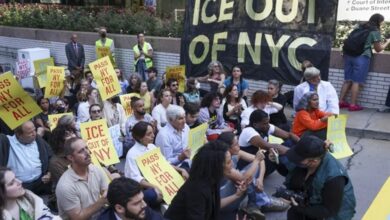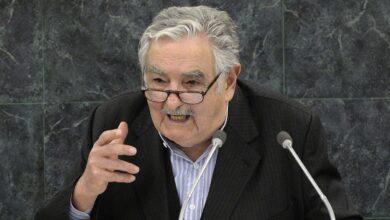South American Crime Boss Captured in New York After Deadly Rampage

Gianfranco Torres-Navarro, a notorious South American crime boss linked to at least 23 murders in Peru, was captured in New York last week. His arrest, alongside his girlfriend, ended a months-long search and raised serious questions about U.S. immigration procedures.
Gianfranco Torres-Navarro, one of South America’s most wanted criminals, was apprehended in New York last week, marking the end of a dramatic international search. Torres-Navarro, 38, is the leader of the violent gang “Los Killers de Ventanilla y Callao,” which has terrorized parts of Peru with a brutal campaign of murder and extortion. His capture, along with his girlfriend Michelle Sol Ivanna Ortíz Ubillús, brought relief to many in Peru but also sparked controversy over how the notorious gang leader was allowed to enter and remain in the United States.
The arrest came just three months after U.S. immigration authorities initially detained Torres-Navarro when he illegally crossed the border from Mexico into Texas. Remarkably, despite his dangerous background, he was released with a notice to appear for immigration proceedings. The oversight has led to significant criticism and questions about the effectiveness of U.S. border security and immigration screening processes.
A Notorious Gang Leader
Gianfranco Torres-Navarro is no ordinary criminal. He is the feared leader of “Los Killers de Ventanilla y Callao,” a gang that has risen to infamy in Peru for its ruthless tactics and violent methods. The gang, which was formed in 2022, primarily operates in the coastal regions near Peru’s main port, where it has established a grip on local construction companies through extortion and violence. Torres-Navarro, known as “Gianfranco 23,” a moniker that chillingly references the number of people he is alleged to have killed or ordered to be killed, has left a trail of death and destruction in his wake.
Before founding “Los Killers,” Torres-Navarro was a member of another notorious criminal organization, “Los Malditos de Angamos.” His rise through the ranks of Peru’s underworld was marked by a series of increasingly violent acts, which eventually led to his leadership of one of the country’s most feared gangs. Peruvian authorities have long sought to bring him to justice, accusing him of crimes ranging from contract killings to extortion and the operation of a sophisticated criminal enterprise.
Michelle Sol Ivanna Ortíz Ubillús, Torres-Navarro’s girlfriend and close associate, has also played a significant role in the gang’s operations. Described as his lieutenant and the gang’s cashier, Ortíz Ubillús managed the criminal enterprise’s financial side while maintaining a public persona on social media, where she flaunted their lavish lifestyle. Her involvement in the gang and the couple’s recent capture has only added to the public intrigue surrounding this case.
A Trail of Blood and Fear
Torres-Navarro’s criminal activities are as brutal as they are extensive. He is believed to be responsible for the deaths of numerous rival gang leaders and their family members, including women and children. According to Col. Franco Moreno, head of Peru’s High Complexity Crime Investigations Division, Torres-Navarro’s reign of terror aimed to consolidate his power and eliminate any threats to his criminal empire.
One of the most shocking incidents linked to Torres-Navarro occurred in February 2023, when he allegedly ordered the assassination of a rival gang leader and five members of his family, including two young children. The murders sent shockwaves through the community and further solidified Torres-Navarro’s reputation as a dangerous and ruthless criminal. In another high-profile case, Torres-Navarro is suspected of being behind the killing of retired police officer Cesar Quegua Herrera, who was gunned down at a restaurant in San Miguel in March.
Peruvian authorities have described Torres-Navarro as a criminal who believed himself to be untouchable. He is accused of personally carrying out some of the murders attributed to his gang, adding to the fear and intimidation that “Los Killers” have sown in the areas under their control. His arrest brings an end to his reign of terror, but the legacy of fear he has left behind will likely linger for years to come.
A Flawed Immigration System
The circumstances surrounding Torres-Navarro’s entry into the United States have raised significant concerns about the efficacy of the U.S. immigration and border control system. On May 16, Torres-Navarro illegally crossed the U.S.-Mexico border near Roma, Texas, where he was quickly detained by U.S. Customs and Border Protection (CBP). However, instead of being held in custody, he was released with a notice to appear in immigration court—a decision that has since come under intense scrutiny.
At the time of his release, it appears that U.S. authorities were unaware of Torres-Navarro’s violent background and his status as a wanted criminal in Peru. Peruvian authorities did not issue an international arrest warrant for Torres-Navarro until July 3, when he had already been released into the U.S. interior. It wasn’t until July 8 that U.S. Immigration and Customs Enforcement (ICE) received information about his criminal history and moved to arrest him once again.
The case has highlighted the challenges faced by U.S. immigration authorities in screening and identifying high-risk individuals who attempt to enter the country. While CBP has stated that it employs a range of resources and information, including international databases, to screen migrants, the apparent failure to identify Torres-Navarro as a dangerous criminal has led to calls for a review of current procedures. Critics argue that the system’s inability to prevent a known gang leader from entering and remaining in the U.S. represents a severe lapse in national security.
Legal Battles and Deportation
Following his capture, Torres-Navarro is currently being held at a federal detention facility in New York, where he awaits an immigration hearing. His girlfriend, Michelle Sol Ivanna Ortíz Ubillús, is also in custody at a processing center in Pennsylvania. Both are likely to face deportation to Peru, where they will be held accountable for their alleged crimes.
Peruvian authorities have welcomed the arrests and are preparing to prosecute Torres-Navarro and his associates for a litany of offenses, including murder, extortion, and the operation of a criminal organization. In recent months, Peruvian police have also made significant strides in dismantling “Los Killers,” arresting several members of the gang in a series of coordinated raids. These arrests, coupled with the capture of Torres-Navarro, represent a significant blow to the gang’s operations, although the full extent of its activities remains to be seen.
As Torres-Navarro’s case moves forward, it will test the U.S. immigration and justice systems’ ability to handle high-profile international criminals. While his eventual deportation to Peru seems likely, the case has already sparked a broader conversation about the need for more rigorous screening and better international cooperation in tracking and apprehending dangerous individuals.
For the people of Peru, the capture of Gianfranco Torres-Navarro is a moment of relief and a small victory in the ongoing battle against organized crime. However, it is also a reminder of the persistent challenges that law enforcement faces in combating criminal networks that operate across borders with impunity. The arrest of Torres-Navarro may have brought an end to one chapter of violence, but the fight against gangs like “Los Killers” is far from over.
Also read: The Glorification of Drug Lords in Latin America and the Caribbean
In the end, Gianfranco Torres-Navarro’s case underscores modern crime’s complexities and difficulties in ensuring justice across international lines. As authorities in both the U.S. and Peru continue to work together, the hope is that this case will lead to improved cooperation and more robust safeguards to prevent similar situations from occurring in the future.





